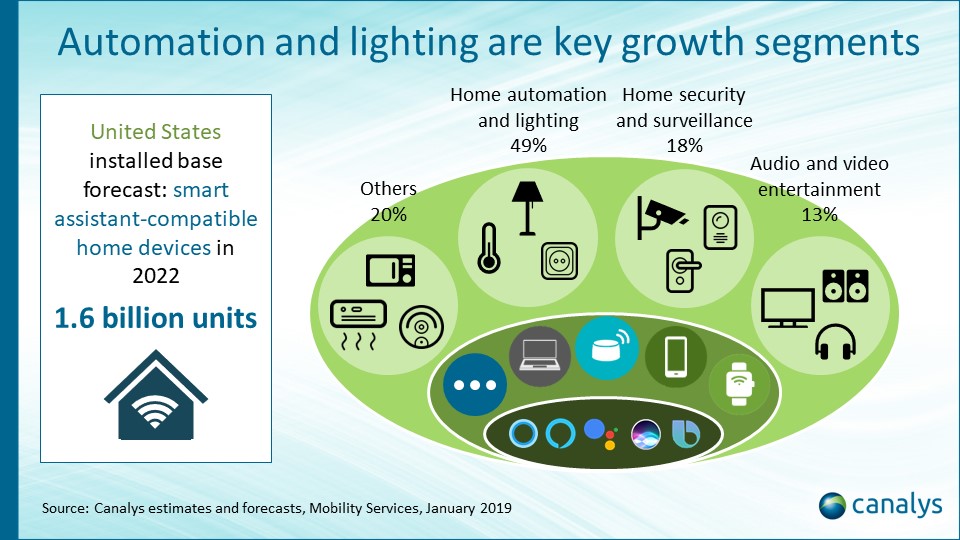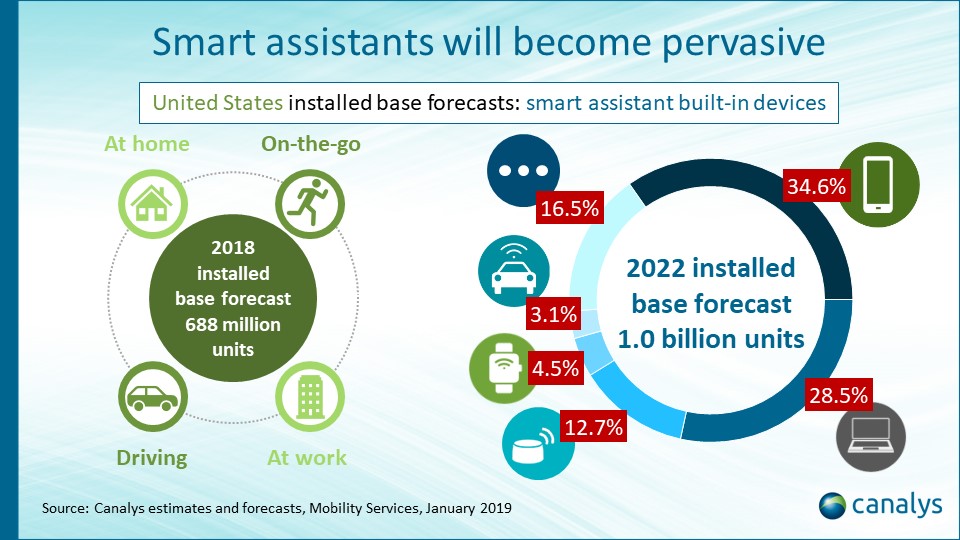Rise of Alexa, Google Assistant and Siri to drive US smart assistant-compatible device base to 1.6 billion in 2022
Palo Alto, Shanghai, Singapore and Reading (UK) – Monday, January 7 2019
The installed base of smart assistant-compatible devices in the home, such as light bulbs, thermostats and door locks, is expected to grow five-fold in the US over the next three years, reaching 1.6 billion in 2022.
"Canalys predicts growth will be driven by improving ease of use, thanks to the voice control offered by smart assistant compatibility with the likes of Amazon’s Alexa and Google Assistant,” said Senior Analyst Jason Low. Canalys estimates that almost half of all devices in use at home will cater to home automation and lighting, with home security second at 18%. “Growth will also be driven by the arrival of cheaper devices. Device sensors will give smart assistants new ‘senses’ that make them aware of the environment, leading to ever more use cases. For example, in lounges and kitchens, where more functionality will be unlocked by smart home devices working collectively with smart assistants.”

In comparison, the total base of smartphones in the US will reach 351 million, while the smart speaker base will be 129 million. Both smartphones and smart speakers are important points of contact for assistants at home. Rather than being “compatible” and operating via relayed commands, smartphones, smart speakers, mobile PCs, smartwatches and connected cars have smart assistants built-in that can act on voice commands.
The growing use of devices where the smart assistants are “built-in” is critical to Canalys’ growth forecast. Canalys predicts that the base of such devices will exceed 1.0 billion in the next three years in the US alone.

2019 will be a testing year for smart assistants. “The adoption of smart assistants is no longer a question of price or availability,” said Nicole Peng, Canalys Senior Director of Mobility. “2018 was a key year for voice, with smart speakers bringing the technology to the fore. Platforms such as Alexa, Google Assistant, Siri and Cortana have since expanded hardware integration and use-cases to cater to a wide audience. 2019, however, will represent a ‘hype check’, especially in the US, where the smart speaker market is fast maturing. The true test will lie in the additional investment users make in the voice ecosystem. In this regard, the popularity and performance of smart assistant-compatible home devices will be critical in 2019.”
Smart assistants will unleash their full potential when they become ubiquitous, working across multiple user-scenarios seamlessly. “This is a long-term battle between platform vendors to control the voice-driven platform of the future. The platforms will serve as touch points to millions of US households. Platform vendors such Amazon, Apple, Google and Microsoft will bet big because of the vast opportunities in uncovering new business models, as well as the possibility of addressing consumer and business demand beyond smart home needs. There will be growth opportunities for nimble and adaptable disruptors, as well as regional players with strong localization capabilities,” said Low.
Definitions
Smart assistant-compatible device : Devices in a connected network that can be operated independently or with relayed voice commands from an off-site smart assistant built-in device.
Smart assistant built-in device : Devices that have in-built smart assistants with the capability to interpret voice commands, and act on them or relay the commands to off-site-compatible devices.
Email Newsletters
Sign up to receive TelecomTV's top news and videos, plus exclusive subscriber-only content direct to your inbox.



